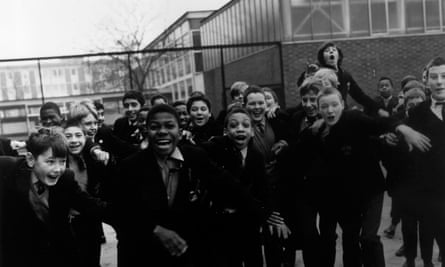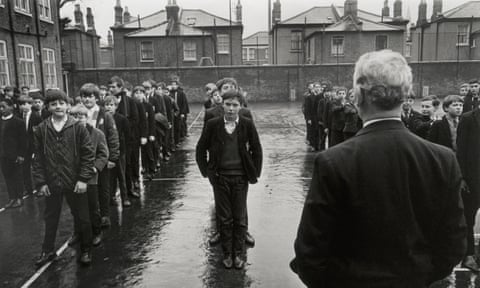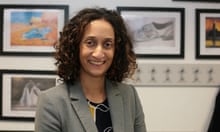A brilliant early summer Saturday in 1967, as I recall. A knock on the front door. A kid who had been in the same class as me at Parr Lane primary school in Unsworth, a 1960s housing development centred on a long-neglected mill village in a stretch of country heading towards the Pennine hills. The area might be known to you as the blur of mid-rise housing, crinkly tin sheds, barbed wire, drainage ditches and litter you see from the M66 if, for some reason, you should take it upon yourself to drive from Manchester to Burnley.
It was mid-morning, and I was supposed to have turned up at the school grounds to play in a game of softball. My visitor’s nickname was Spud – universally thought of as being dumb, the victim of countless playground hoaxes and practical jokes. Spud had been sent to get me. I was needed to make up the numbers. I said I didn’t feel like it. Spud persisted. It would spoil things if they didn’t have enough players to make two equal teams. Anyway, everyone was having a laugh because they’d got their 11-plus letters and, as it turned out, the whole team had passed. Spud hesitated and checked if I had got mine. I told him that I had not received my letter. This was a lie.
Earlier that morning the postman had called, and my mum and dad had opened the letter. I had failed the 11-plus. This was a shock. At age 11 it had been scientifically determined that I was stupid. I remain to this day a member of that segment of the British population who are not only dim-witted but officially clueless, with a letter from the government to prove it. That was just the way of it – a stone‑cold, independently verified, rock-hard fact. I went upstairs to my bedroom, drew the curtains and sobbed for days.
There was a token right to appeal. But the local grammar school was so oversubscribed that, during a trip to my headmaster’s office the following Monday, it became clear that this was purely theoretical. The headmaster candidly explained that the grammar school basically never took kids on appeal because it was too much trouble and, anyway, they didn’t need to. “Sometimes life throws you a googly,” he smiled, sympathetically. “The thing is to keep a straight bat.” I had no idea what this meant, and I still don’t.
Part of my problem was that I not been aware that you were supposed to game the system. I had not practised the 11-plus in advance. This was probably my downfall. As recently as March 2017, the former headmaster of Manchester grammar school popped up on Radio 4’s The Moral Maze to explain that no child who had not seen the verbal reasoning tests that formed the basis of the 11-plus before attempting them would have a “hope in hell” of passing them. The headmaster said that he had organised selection by academic merit, and dispensed with the 11-plus as “worthless”. Instead he used personal interviews. “If you can detect a sense of irony in an 11-year-old, then you know they are clever,” he said.
When I was 10, my parents had moved from Stretford to Unsworth: “the countryside”, as they thought of it, and part of a different education authority. The kids I joined had been drilled in the 11-plus until it was coming out of their ears. And I had not. Neither my family nor I had any idea that you could buy little booklets from newsagents that showed you how to pass the exam and contained lots of past papers with all the answers provided.
My parents had been at primary school in the 1930s and although intelligent, were clueless about how to work the education system. Had they known about the practice booklets, the 11-plus might well have been a doddle – as it was, even for Spud. Without the booklets … well, as the headmaster said, you didn’t have a “hope in hell”.
At her first press conference after becoming prime minister, in September 2016, Theresa May announced that secondary education policy was about to be turned upside down. A new era of meritocratic fairness was to be inaugurated. The key to this would be, of all things, the reintroduction of selection, including the building of new grammar schools.
The debate about selection and grammar schools had run on for years. A system that used a single test to cream off the top tier of pupils for the better schools had come to be widely accepted by the educational establishment and by most politicians as grossly unfair. The creation of grammar schools that could select their own pupils condemned the rest to vastly inferior secondary moderns – which sometimes did their best despite having the system stacked against them – and technical colleges. Data has proven that the two- or three-tier system was a disaster. But the test was retained in a few places including Kent and, ironically from my point of view, Stretford (now under the control of the Trafford local authority).

The drive for comprehensive secondary education had been part of a postwar consensus that saw education as part of a Scandinavian-style egalitarian social democratic society. Most kids would go to their local secondary school, where they would encounter a range of people from different social and cultural backgrounds, which would help to foster a strong, diverse society in the following generations. This was the general social good for which the comprehensive system aimed. It was inextricably linked to similarly comprehensive provision in healthcare and housing.
May’s vision is very different. Parents, she said, had been operating a system of “selection by house prices” in the secondary system. She would put an end to that by reintroducing “selection by academic merit”.
“Politicians – many of whom benefited from the very kind of education they now seek to deny to others – have for years put their own dogma and ideology before the interests and concerns of ordinary people,” she said. Her answer was to overturn the nostrums of the anti-selective “educational elite” and bring back selective grammar schools.
Her government, she said, would be all about creating opportunities for “ordinary working-class families” – the sort of people who had been ignored and even despised by a national elite of policymakers and other shadowy and ill-defined power-brokers. The chief characteristic this elite exhibited was hypocrisy: they opposed selection and grammar schools, but sent their own kids to private schools or used their higher salaries to move to the catchment areas of popular or successful comprehensive schools, leaving failing schools behind to be occupied by the poor.
In her speech, May said the reintroduction of grammar schools and selection would not lead to the simultaneous reintroduction of secondary modern schools. She gave vague assurances that selection did not imply any sort of superiority or inferiority. There would be “parity of esteem” between the two types of institution. The difficulty is that this was exactly what was said when the grammar school and secondary modern system was set up in 1944.
There was one group missing from the debate on grammar schools: those who had failed the 11-plus and ended up at secondary modern schools. Between 1944 and 1976 around 30 million people took the test. More than 20 million of us failed. The nostalgia for grammar schools is confined to those who passed the exam, and felt it gave them a chance in life. But the experience of those who failed is rarely – if ever – heard first-hand, for the very good reason that hardly any of them went on to higher education or positions in life where they had any sort of voice at all.
It turns out that I am the same age as Theresa May. Our birthdays are separated by a matter of days. And so we would have sat the 11-plus on the same day in 1967. She presumably passed. She went to Holton Park girls’ grammar school in Oxfordshire (which became Wheatley Park comprehensive a year after she arrived), and then to Oxford University, where she studied geography. I failed, and went to Wellington county secondary modern school, a red-brick Edwardian institution resembling a prison and located in the centre of Bury, a stupendously ugly and rundown mill town to the north of Manchester.
Wellington had slits for windows, and upper internal galleries and walkways overlooking an assembly area somewhat on the Strangeways prison model. Wellington school – “Welly”, as it was universally derided – has been demolished and not a trace of it remains. The highest achiever from Wellington, at least in my era, is Alan Whitehead, who played professional football for Bury and Brentford FC at centre-half.
What I remember about Welly most of all was the cold. The heating was ancient and rarely worked. And the noise. The prison-like layout of the place meant there was a steady background cacophony from whichever class was at that moment in open revolt. Every hour a bell would ring and bedlam would ensue. It was co-educational in theory, but strictly segregated, with separate entrances and playgrounds for boys and girls.
Having failed the 11-plus, there was yet more selection to come. This time, it came in the form of rigid streaming, which seemed to have more to do with social segregation than even the pretence of any assessment of ability. I found myself in a stream with other kids who primarily came from overflow estates in the south of Bury, closer to Manchester. The resulting growth in school numbers meant that we were accommodated in a series of cheap and freezing improvised annexes similar to Portakabins.
Our presence was resented on the grounds that we were stealing school places and housing, as is always the way with economic migrants. The other stream consisted mainly of locals whose families came from solidly yokel Bury mill and farm labourer stock. Some of these people were extremely hard, and had accents so thick that we incomers could hardly understand what they were saying. Many students had come to the conclusion that they were in effect being imprisoned until the day they left, in order to comply with the school leaving age, which was about to be raised from 15 years to 16, and the various factory acts that, much to their regret in some cases, outlawed child labour. The change to 16 was made in 1972, so my last year at Welly was spent in the company of some extremely disgruntled hard cases who, as they saw it, had arbitrarily had their sentences increased.
I liked a lot of the teachers, but many had difficulty exerting even basic control over their classrooms. There was a constant air of violence about the place, and physical attacks on teachers were not unknown. For a time, there was also an improvised isolation unit in the style of an animal pen, knocked up with four-by-two and chipboard in the assembly area. It was known as the “sin bin”. You could walk along the gallery on the upper floor and look down to see some kid sitting inside the pen staring at the wall, Alcatraz-style, with teachers standing guard on a rota.
Three subject areas were taken seriously by the school: religious education, woodwork for boys and domestic science for girls. Metalwork seemed to disappear from the curriculum after the tough kids turned the lathe area into a weapons factory, manufacturing a steady stream of improvised but deadly-looking crossbows. Girls were not allowed to do woodwork because it was too dangerous and “unladylike”. Instead they had a specially arranged workshop set out like a kitchen with rows of ironing boards, where they could practise doing things such as washing dishes and ironing clothes. Many of the girls had evidently bought into the trainee housewife role, so it was a truth universally acknowledged that they were on the lookout not so much for a boyfriend, but an actual husband – meaning someone considerably older than me. In subjects such as maths and English, many of the girls – not all – would sit at the back of classroom knitting, casting withering glances, crocheting or reading Jackie magazine – the definitive 1970s guide on how to land a proper boyfriend (ie not me).
The staff were an odd bunch. Taking a position in a secondary modern school by the late 1960s must have amounted to professional suicide for any schoolteacher. We tended therefore to get older ones from the local area who were, frankly, either crazy or borderline alcoholic and couldn’t get hired by a grammar school. They tended to teach the core subjects such as woodwork, domestic science or some other soon-to-be redundant vocational skill such as, my own particular favourite, technical drawing. This was a marvellous thing where you needed to stand at drawing boards doing super-accurate scaled floor plans of imaginary power stations. Nobody mentioned the existence of an activity called architecture, however.
Then there was a group of younger teachers fresh from college. This being 1968, the student revolution was in full swing, and many of these younger teachers were pioneering advocates of the counterculture. A lot of them smoked weed, or at least talked about it. I recall an English teacher who was permanently hungover and whose lesson plan often consisted of throwing away the set text, lighting up a blunt one and playing Bob Dylan records on the grounds that this was poetry. At one point, there was a crackdown and the headmaster tried to get him to at least use an ashtray and to plough through some novel or other. It was later discovered that he was by profession a long-distance lorry driver who had forged his teaching certificate. There was a brilliant history teacher who looked exactly like Janis Joplin – a sort of raving haystack of hair and communist sloganeering. She was an enthusiastic Maoist, who actually brought a copy of the Little Red Book into class for “show and tell”.
Secondary education in the 1930s – my parents’ generation – had not been universal. The system of ancient public schools leading towards university education was well established for those who could afford it. For the rest, there was a chaotic patchwork of private and state-funded schools. It was Rab Butler’s 1944 Education Act, or rather its implementation by a Labour government between 1945 and 1950, which produced the 11-plus and “tripartite” division of secondary education between grammar, technical and secondary modern schools.

There would be a number of grammar schools as an option for the more academically inclined. A larger number of technical schools would specialise in teaching trade skills, followed by more advanced craft training to become a skilled worker in newfangled professions such as electrical engineering. For the rest, secondary modern schools were to prove a broad, general education. Most children would attend these schools until the age of 14 or 15, after which it was envisaged they would get a job and probably become an apprentice or continue to receive some sort of on-the-job training from their employer. All that remained was to provide a scientific method of accurately matching each child with the role most appropriate for them in the emerging brave new world of the technological society.
Few people have touched the lives of so many so directly as Cyril Burt, the educational psychologist who devised those parts of the 11-plus designed to test the general intelligence of one child against another. He remains a controversial figure, though his role is hardly known outside the world of clinical psychology and educational theory. Burt’s entire life was a quest to define and measure human intelligence, and thus to make the process of education scientific. He came to prominence in 1909 after publishing a paper showing that “general intelligence” (as opposed to ability to perform some specific task) was primarily – and perhaps entirely – a matter of genetics and inheritance. The same study also demonstrated that men and women were equal in terms of general natural intelligence. If it was possible to accurately determine the general intelligence of a person, then it would be possible to devise a programme of education perfectly suited to them as an individual, just as a doctor would diagnose a patient and give the appropriate medicine.
Before the first world war, Burt had developed a machine to diagnose “slow-witted” children (who thus qualified for special needs education), while working as school psychologist for the London county council. The machine produced stimuli such as flashing lights and clicking noises and measured response and reaction times, down to differences measured in fractions of a second.
Through the 1920s and 30s, Burt turned to timed paper and pencil tests requiring abstract non-verbal reasoning – essentially the ability to spot patterns in series of symbols and draw valid inferences quickly. Performance in these tests would be used to rank a person’s general intelligence, providing a score that, when combined with other tests, would come to be known as an intelligence quotient, IQ. But herein lies the central objection to IQ testing in principle. A person can easily be trained to perform well in an IQ test if they know they are going to be required to take one.
Even if the three-way division were accepted as making sense, the problem of detecting each type of person and selecting them for the right type of institution arises. Eventually, the 11-plus would be used for this purpose. But this was not the plan at first. Cabinet papers from the period show that the intention was that the process of selection would be a form of careers advice or counselling, taking the educational and career ambitions and expectations of the parents and the children into account – a process in which intelligence testing would be used as one of several ways of making a decision as part of civilised and considered process.
During the second world war, Burt worked with the Cambridge academics planning the post-war tripartite secondary system to develop the 11-plus test – not as a gateway selection test, but as a diagnostic tool to help people come to informed decisions about their educational needs. The 11-plus, just like Burt’s earlier “thinking-speed” detector, would certainly identify people with either very high or low cognitive abilities. What forced the 11-plus centre stage was not ideology, psychology or educational theory, but economics and demographics. In some years in the 1950s, the number of babies born was almost double that of the worst years of the 1930s. I am one of those babies, or used to be anyway.
Through the 50s and 60s, such additional grammar school places as the government could afford to provide were insufficient to keep up with demand. Couples kept having babies and the government had to find places to put them. And so, although it had started life as a diagnostic tool useful for making an informed decision, the 11-plus became a means of rationing a scarce resource, easily manipulated by means of cramming in order to capture a position on the educational ladder. As the social cachet of grammar school places rose, so the stock of the standard secondary modern and the technical schools declined. They quickly came to be seen not as a valid alternative choice, but as second-, third- or fifth-rate versions of grammar schools. The 11-plus test came to be widely feared and disliked as a crude rationing mechanism that the well-informed could manipulate.
The whole idea of the IQ test was damaged by the public career of Burt’s most famous pupil, Hans Eysenck. Through the 1960s and 70s, Eysenck linked Burt’s contention that intelligence was a matter of inheritance and not environment to racial differences and supposed “scientific proof” of differences in intelligence between races that would not be eradicated by education. This led to a backlash against the whole idea of IQ among some educationalists and the development of rival schools of thought that fought it out in the universities and academic literature. This was ideological bedrock: a version of the age-old “nature v nurture” debate. Did personality, including intelligence and other aptitudes, mainly arise from biological differences? Or was it the result of social and cultural factors that could be corrected or built upon for both the private and public good? By the time Cyril Burt died in 1971, the “nurture” school was in the ascendant. The wheel of intellectual respectability had turned. His reputation was further damaged by allegations that he had faked test results used in academic research.
The row over the “Burt affair” rumbles on in academia to this day. By 1976, when the 11-plus was being phased out across the country, some 30 million people had taken the test.
One galling aspect of selection and the grammar school system is the impossibility of providing a single form of final school-leaving qualification for all pupils that makes sense. If teenagers at different types of school are following different curriculums, then they cannot very well take the same final examinations when they are finished. Theresa May’s reinstituted grammar schools will create pressure for their own final examinations and qualifications. These, inevitably, will be seen as superior to whatever examinations are offered by secondary moderns, or whatever they will be called for PR reasons. Equal-but-different kids following tailored-to-needs curriculums will require equal-but-different qualifications at the end. And these qualifications will have a lifelong effect.
This was the way of it before the abolition of selection in most parts of the country. Grammar schools offered the General Certificate of Education at two levels – Ordinary at the end of the fifth year and Advanced (university entrance) at the end of sixth form. But, as a secondary modern student, I simply was not allowed to either follow the O-level curriculum or to take the examinations, and my school did not offer A-levels at all. Instead I was required to take Certificate of Secondary Education examinations, based on different curriculums. These qualifications were, of course, said to have been “equal but different” to O-levels, but nobody believed that for a moment. Eventually, the difference was ratified by a grading system that ranked the highest grade in CSE exams as equivalent to the lowest possible passing O-level grade. I do recall a sense of absolute fury at a system that was so obviously and nakedly fixed.
The bureaucrats, however, had left a loophole in the system, which I decided, out of sheer rage, to exploit. If you took the compulsory – but worthless – CSE exams, you could in addition take the GCE exams with the permission of your school. In some subjects – such as history, some of the sciences and art – the material to be learned was similar, and so it was easily manageable. With maths and English, I ended up having to master two curriculums, which was harder, but still doable. That year, I took something like 40 exam papers over a period of a few weeks. I ended up with top grades in around 24 subjects and a write-up on the front page of the Bury Times. My plan had been to strike back at an unjust system by reducing it to ridicule, and, to a degree, it worked. Here was an education system that had classified me as officially one of the stupidest people in the country, and, at the same time, as one of the cleverest.
I remember when I failed the 11-plus, my dad looked achingly disappointed, but resigned. He comforted my mum by saying that he would be able to get me an apprenticeship in the printers where he worked in Salford. He was a welder in the maintenance department. But he reckoned I would be able to train as a print machine minder. That was a well-paid job and a step up in the social pecking order. It was a reasonable plan at the time, but fortunately it was not implemented. If I had gone that way, the apprenticeship would have led to five or six years of graft, losing the habits of education and learning a trade that became entirely redundant in about 1980. Both my cousins worked in “the print” for a while, but they never found regular work after the industry collapsed. They suffered terrible health problems and died young. Others I knew at Welly had a series of increasingly desperate semi-skilled or unskilled jobs, which disappeared in the great recessions of the 1980s.

There is much affectionate nostalgia now for the idea of craft apprenticeships. But like the 11-plus itself, few of the people expressing this fondness actually experienced either selection for non-academic education, or an apprenticeship, themselves. The apprenticed craft for which I might have been prepared – that of a skilled print worker – was superseded when computers came along. It strikes me that apprenticeships may have made more sense in the less dynamic economy of, say, the 16th century, when the role of, say, dung collector, was passed down through the generations as a feudal title, protected by the restrictive practices of a trade guild. But the pace of technical change is now so rapid that any skill you might now train to acquire is likely to become redundant before you have finished training for it. The government agency tasked with training is, I see, still offering an apprenticeship in being a heavy goods vehicle driver (at two levels – basic and intermediate) when everyone thinks that most driving jobs will be fully automated in the near future. A heavy goods vehicle driving apprenticeship – like, ultimately, all other apprenticeships – merely puts the journeyman on an economic road to nowhere.
This story has a happy ending of sorts, for me at least. Fifty years ago on that sunlit day when I received my 11-plus letter I was nearly put on a very different path, on that would have been catastrophic – even fatal – for me, as it was for so many millions of others. However, the fact that I had very little formal education, at least as it would now be recognised, meant that I learned the art of a sort of aggressive self-education and the ability to quickly brief myself on any topic. When school was finished, I had an entry interview at the University of Warwick, and managed to talk myself into a place – just about. One final system-imposed hurdle was the weird and apparently random combination of A-level qualifications I had obtained, which did not hang together in any coherent way. They were based on whatever reading had grabbed my attention at the time, rather than any sort of plan to get into university. I managed to explain all this to sceptical admissions tutors. I got in and had a ball.
But this was not the case for most 11-plus failures. They were more inclined than me to turn the other cheek and accept defeat. Most of them probably gave up thinking, on the simple and reasonable grounds that it was an activity for which people with fancy titles in officialdom had found them to be entirely unsuited. Many were crushed by the experience of failing the 11-plus, as I almost was. Most of the kids I was with at Welly were at least as intelligent as me, and many were brilliant. Some were probably dyslexic, before the condition was really recognised. Few of them went on to higher education. Who will speak for them?










